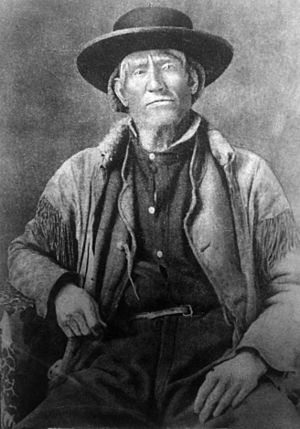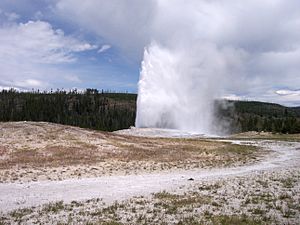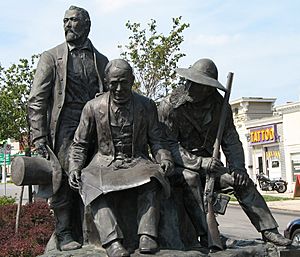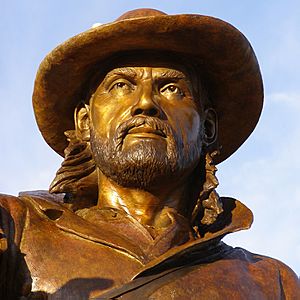Jim Bridger facts for kids
Quick facts for kids
Jim Bridger
|
|
|---|---|

Bridger around 1876
|
|
| Born |
James Felix Bridger
March 17, 1804 |
| Died | July 17, 1881 (aged 77) |
| Occupation | Frontiersman, explorer, hunter, trapper, scout, guide |
| Employer | Rocky Mountain Fur Company, U.S. Government |
| Known for | Famous mountain man of the American fur trade era |
| Spouse(s) | Three Native American wives: one Flathead and two Shoshone |
| Children | 5 |
| Relatives | 3 spouses all Native American, one Flathead and two Shoshone |
| Military career | |
| Allegiance | |
| Service/ |
|
| Years of service | 1859–1860 |
| Rank | Scout |
| Unit |
|
| Commands held | Rifleman |
| Battles/wars | Raynolds Expedition |
James Felix Bridger (born March 17, 1804 – died July 17, 1881) was a famous American mountain man. He was also a trapper, Army scout, and wilderness guide. He explored and trapped in the Western United States in the early 1800s.
Bridger was one of the first American mountain men to explore the West. He followed in the footsteps of the Lewis and Clark Expedition. He became well known for joining many early trips into the western lands. He also helped make peace between Native American tribes and European-American settlers moving west.
By the end of his life, he was known as one of the best frontiersmen in the American Old West. He was very strong and could survive tough conditions. He explored the Rocky Mountains from southern Colorado all the way to the Canadian border. He could speak French, Spanish, and several Native American languages.
In 1830, Bridger and his friends bought a fur company. They named it the Rocky Mountain Fur Company.
Contents
Early Life and Adventures
James Felix Bridger was born on March 17, 1804, in Richmond, Virginia. His father, James Bridger, ran an inn. His mother was Chloe. Around 1812, his family moved near St. Louis. This area was at the edge of America's huge new western frontier.
When Bridger was 13, both his parents died. He had no formal schooling and could not read or write. He became an apprentice to a blacksmith. He remained unable to read or write his whole life.
On March 20, 1822, at age 18, he left his blacksmith job. He saw an ad in a St. Louis newspaper. He joined General William Henry Ashley's fur trapping trip to the upper Missouri River. This group included Jedediah Smith and many other future famous mountain men. For the next 20 years, Bridger traveled across the American interior. He went from the Canadian border to southern Colorado. He also traveled from the Missouri River west to Idaho and Utah. He worked in the fur trade as an employee or partner.
The Hugh Glass Story
A famous story tells of a bear attack on Hugh Glass in 1823. Glass was badly hurt by a grizzly bear. The group was near the Grand River in South Dakota. Two men, John Fitzgerald and a man named 'Bridges', stayed with Glass. They thought he was dying. They later left him, taking his rifle and other gear. They told the main group that Glass had died. It is possible that 'Bridges' was Jim Bridger, but it is not certain.
Exploring Yellowstone and the Great Salt Lake


Bridger was one of the first mountain men to explore the amazing natural sights of the Yellowstone area. In the fall of 1824, Bridger explored the Great Salt Lake region. He reached it by using a bull boat.
Guide and Advisor
In 1843, Bridger and Louis Vasquez built Fort Bridger. It was located on the Blacks Fork of the Green River. This fort was an important stop along the Oregon Trail.
Bridger had explored, trapped, hunted, and found new paths in the West since 1822. Later, he worked as a wilderness guide in these areas. He was very good at giving advice to any group traveling West. He knew all the trails and could help them reach their destination.
In 1846, the Donner Party came to Fort Bridger. Bridger and Vasquez told them that Lansford Hastings' shortcut was a "fine, level road." They said it had plenty of water and grass, except for one 40-mile dry stretch. However, the dry stretch was actually 80 miles long. The "fine level road" was very difficult. This slowed the Donner Party down and caused them great trouble.
In 1859, Bridger was hired as the main guide for the Raynolds Expedition. This trip, led by Captain William F. Raynolds, was heading to Yellowstone. Bridger guided the expedition over Union Pass. Other mountain passes were blocked by snow. Even though they did not reach the Yellowstone Plateau, the expedition explored Jackson Hole and the Teton Range.
Bridger Pass and the Bridger Trail
In 1850, Bridger was guiding the Stansbury Expedition back from Utah. During this trip, he found what became known as Bridger Pass. This was a new route that bypassed South Pass. It shortened the Oregon Trail by 61 miles. Bridger Pass is in south-central Wyoming. It later became the path for both the Union Pacific Railroad and Interstate 80.
In 1864, Bridger created the Bridger Trail. This was another route from Wyoming to the gold fields of Montana. It helped travelers avoid the dangerous Bozeman Trail. In 1865, he worked as a guide and U.S. Army scout. He helped during the first Powder River Expedition. This was against the Sioux and Cheyenne tribes who were blocking the Bozeman Trail. He left the Army at Fort Laramie later that year.
Bridger suffered from health problems like goiter, arthritis, and rheumatism. In 1868, he returned to Westport, Missouri. He tried to get back rent from the government for using Fort Bridger, but he was not successful.
Family and Death
In 1835, Bridger married a woman from the Flathead Indian tribe. He named her "Emma." They had three children together. Emma died in 1846 from a fever.
After Emma's death, he married the daughter of a Shoshone chief. She died three years later while giving birth. In 1850, he married the daughter of Shoshone Chief Washakie. They raised two children.
Some of his children were sent back East for school. His firstborn, Mary Ann, was killed by a group of Native Americans while being tutored. His son Felix fought in the Missouri Artillery and died of sickness. His daughter Josephine also died. This left his daughter Virginia as his only living child.
Jim Bridger died on his farm near Kansas City, Missouri, on July 17, 1881. He was 77 years old.
Legacy


Historical Reputation
Bridger is remembered as one of the most interesting and well-traveled mountain men of his time. Besides his explorations and guiding, he was known for his storytelling. His stories about the geysers at Yellowstone, for example, turned out to be true.
Other stories were greatly exaggerated or just meant to be funny. One of Bridger's stories was about a petrified forest. He said there were "petrified birds" singing "petrified songs." He may have seen real petrified trees in Yellowstone National Park. Over the years, Bridger became so famous for telling tall tales that many stories made up by others were also said to be his.
One of Bridger's favorite stories to tell new people was about being chased by one hundred Cheyenne warriors. After being chased for miles, Bridger found himself at the end of a box canyon. The Native Americans were closing in. At this point, Bridger would stop talking. His listener would ask, "What happened then, Mr. Bridger?" Bridger would reply, "They killed me."
Places and Things Named for Jim Bridger
Many places and things are named after Jim Bridger:
- Fort Bridger
- Fort Bridger, Wyoming
- Bridger, Montana
- Bridger Bay, Utah (a bay in the Great Salt Lake)
- Bridger Bay Beach, Utah (a beach on Antelope Island)
- Bridger Mountains (Wyoming)
- Bridger Mountains (Montana)
- Bridger Peak in Utah
- Bridger Wilderness
- Bridger Bowl Ski Area
- Bridger-Teton National Forest
- Bridger Pass
- Jim Bridger Power Station
- Bridger Lake, a lake and campground near Mountain View, Wyoming
- Bridgerland in Cache Valley in Utah and Idaho. Many businesses and schools in Logan, Utah use this name.
- James Bridger Middle School in Independence, Missouri
- Jim Bridger Elementary School in Portland, Oregon
- Jim Bridger Elementary School in West Jordan, Utah
- The Jim Bridger cabins, a motel in Gardiner, Montana, near Yellowstone National Park.
- In 2013, the football rivalry between Utah State and Wyoming was named Bridger's Battle. The winner gets a special rifle called the "Bridger rifle."
Media Portrayals
Jim Bridger has been shown in many movies and TV shows:
- Raymond Hatton played Bridger in the 1940 film Kit Carson.
- Van Heflin played Bridger in the 1951 film Tomahawk.
- Dennis Morgan played Bridger in the 1955 film The Gun That Won the West.
- Karl Swenson played Bridger in the "The Jim Bridger Story" episode of Wagon Train in 1961.
- James Wainwright played Bridger in the 1976 TV movie Bridger.
- Gregg Palmer played Bridger in the 1977 episode "Kit Carson and the Mountain Man" of Walt Disney's Wonderful World of Color.
- Reb Brown played Bridger in the 1978 TV miniseries Centennial.
See also
 In Spanish: Jim Bridger para niños
In Spanish: Jim Bridger para niños



